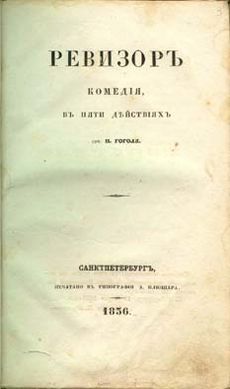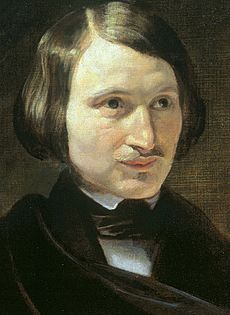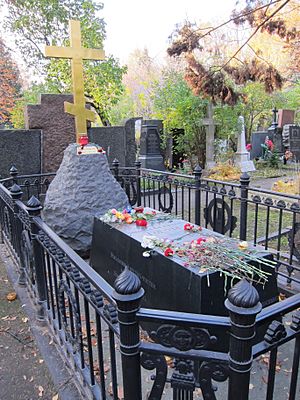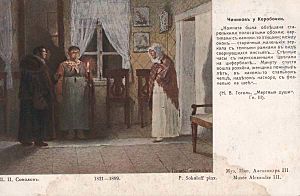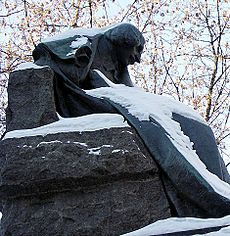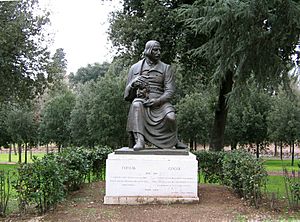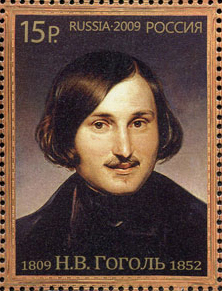Nikolai Gogol facts for kids
Quick facts for kids
Nikolai Gogol
|
|
|---|---|

Daguerreotype of Gogol taken in 1845 by Sergei Lvovich Levitsky (1819–1898)
|
|
| Born | Nikolai Vasilyevich Yanovsky 20 March 1809 (OS)/1 April 1809 (NS) Sorochyntsi, Poltava Governorate, Russian Empire |
| Died | 21 February 1852 (aged 42) Moscow, Moscow Governorate, Russian Empire |
| Resting place | Novodevichy Cemetery |
| Occupation | Playwright, short story writer, novelist |
| Language | Russian |
| Period | 1840–51 |
| Notable works |
Petersburg Tales (1833–1842)
|
|
|
|
| Signature |  |
Nikolai Vasilyevich Gogol (1 April [O.S. 20 March] 1809 – 4 March [O.S. 21 February] 1852) was a Russian novelist, short story writer and playwright of Ukrainian origin.
Gogol was one of the first to use the technique of the grotesque, in works such as "The Nose", "Viy", "The Overcoat", and "Nevsky Prospekt". These stories, and others such as "Diary of a Madman", have also been noted for their proto-surrealist qualities. According to Viktor Shklovsky, Gogol's strange style of writing resembles the "ostranenie" technique of defamiliarization. His early works, such as Evenings on a Farm Near Dikanka, were influenced by his Ukrainian upbringing, Ukrainian culture and folklore. His later writing satirised political corruption in contemporary Russia (The Government Inspector, Dead Souls), although Gogol also enjoyed the patronage of Tsar Nicholas I who liked his work. The novel Taras Bulba (1835), the play Marriage (1842), and the short stories "The Tale of How Ivan Ivanovich Quarreled with Ivan Nikiforovich", "The Portrait" and "The Carriage", are also among his best-known works.
Many writers and critics have recognized Gogol's huge influence on Russian, Ukrainian and world literature. Gogol's influence was acknowledged by Fyodor Dostoevsky, Mikhail Saltykov-Shchedrin, Ryūnosuke Akutagawa, Franz Kafka, Mikhail Bulgakov, Vladimir Nabokov, Flannery O'Connor and others. Eugène-Melchior de Vogüé said: "We all came out from under Gogol's Overcoat."
Contents
Early life
Gogol was born in the Ukrainian Cossack town of Sorochyntsi, in the Poltava Governorate of the Russian Empire. His mother was descended from Leonty Kosyarovsky, an officer of the Lubny Regiment in 1710. His father Vasily Gogol-Yanovsky, who died when Gogol was 15 years old, was supposedly a descendant of Ukrainian Cossacks (see Lyzohub family) and belonged to the 'petty gentry'. His father wrote poetry in Ukrainian as well as Russian, and was an amateur playwright in his own theatre. As was typical of the left-bank Ukrainian gentry of the early nineteenth century, the family spoke Ukrainian as well as Russian. As a child, Gogol helped stage plays in his uncle's home theater.
In 1820, Nikolai Gogol went to a school of higher art in Nezhin (Nizhyn) (now Nizhyn Gogol State University) and remained there until 1828. It was there that he began writing. He was not popular among his schoolmates, who called him their "mysterious dwarf", but with two or three of them he formed lasting friendships. Very early he developed a dark and secretive disposition, marked by a painful self-consciousness and boundless ambition. Equally early he developed a talent for mimicry, which later made him a matchless reader of his own works and induced him to toy with the idea of becoming an actor.
On leaving school in 1828, Gogol went to Saint Petersburg, full of vague but ambitious hopes. He desired literary fame, and brought with him a Romantic poem of German idyllic life – Hans Küchelgarten, and had it published at his own expense, under the pseudonym "V. Alov." The magazines he sent it to almost universally derided it. He bought all the copies and destroyed them, swearing never to write poetry again.
Literary development
In 1831, the first volume of Gogol's Ukrainian stories (Evenings on a Farm Near Dikanka) was published, and met with immediate success. A second volume was published in 1832, followed by two volumes of stories entitled Mirgorod in 1835, and two volumes of miscellaneous prose entitled Arabesques. At this time, Russian editors and critics such as Nikolai Polevoy and Nikolai Nadezhdin saw Gogol as a regional Ukrainian writer, and used his works to illustrate the specific of Ukrainian national characters. The themes and style of these early prose works by Gogol, as well as his later drama, were similar to the work of Ukrainian-language writers and dramatists who were his contemporaries and friends, including Hryhory Kvitka-Osnovyanenko. However, Gogol's satire was much more sophisticated and unconventional.
At this time, Gogol developed a passion for Ukrainian Cossack history and tried to obtain an appointment to the history department at Saint Vladimir Imperial University of Kiev. Despite the support of Alexander Pushkin and Sergey Uvarov, the Russian minister of education, the appointment was blocked by a bureaucrat on the grounds that Gogol was unqualified. His fictional story Taras Bulba, based on the history of Zaporozhian Сossacks, was the result of this phase in his interests. During this time, he also developed a close and lifelong friendship with the historian and naturalist Mykhaylo Maksymovych.
In 1834, Gogol was made Professor of Medieval History at the University of St. Petersburg, a job for which he had no qualifications. Gogol resigned his chair in 1835.
Between 1832 and 1836, Gogol worked with great energy, and had extensive contact with Pushkin, but he still had not yet decided that his ambitions were to be fulfilled by success in literature. During this time, the Russian critics Stepan Shevyrev and Vissarion Belinsky, contradicting the earlier critics, reclassified Gogol from a Ukrainian to a Russian writer. It was only after the premiere of his comedy The Government Inspector (Revizor) at the Alexandrinsky Theatre in St. Petersbrug, on 19 April 1836, that he finally came to believe in his literary vocation. The comedy, a satire of Russian provincial bureaucracy, was staged thanks only to the intervention of the emperor, Nicholas I. The Tsar was personally present at the play's premiere, concluding that "there is nothing sinister in the comedy, as it is only a cheerful mockery of bad provincial officials."
From 1836 to 1848, Gogol lived abroad, travelling through Germany and Switzerland. Gogol spent the winter of 1836–37 in Paris, among Russian expatriates and Polish exiles, frequently meeting the Polish poets Adam Mickiewicz and Bohdan Zaleski. He eventually settled in Rome. For much of the twelve years from 1836, Gogol was in Italy, where he developed an adoration for Rome. He studied art, read Italian literature and developed a passion for opera.
Pushkin's death produced a strong impression on Gogol. His principal work during the years following Pushkin's death was the satirical epic Dead Souls. Concurrently, he worked at other tasks – recast Taras Bulba (1842) and The Portrait, completed his second comedy, Marriage (Zhenitba), wrote the fragment Rome and his most famous short story, "The Overcoat".
In 1841, the first part of Dead Souls was ready, and Gogol took it to Russia to supervise its printing. It appeared in Moscow in 1842, under a new title imposed by the censorship, The Adventures of Chichikov. The book established his reputation as one of the greatest prose writers in the language.
Later life and death
After the triumph of Dead Souls, Gogol's contemporaries came to regard him as a great satirist who lampooned the unseemly sides of Imperial Russia. They did not know that Dead Souls was but the first part of a planned modern-day counterpart to the Divine Comedy of Dante. The first part represented the Inferno; the second part would depict the gradual purification and transformation of the rogue Chichikov under the influence of virtuous publicans and governors – Purgatory.
In April 1848, Gogol returned to Russia from a pilgrimage to Jerusalem and passed his last years in restless movement throughout the country. While visiting the capitals, he stayed with friends such as Mikhail Pogodin and Sergey Aksakov. During this period, he also spent much time with his old Ukrainian friends, Maksymovych and Osyp Bodiansky. He intensified his relationship with a starets or spiritual elder, Matvey Konstantinovsky, whom he had known for several years. Konstantinovsky seems to have strengthened in Gogol the fear of perdition (damnation) by insisting on the sinfulness of all his imaginative work. Exaggerated ascetic practices undermined his health and he fell into a state of deep depression. On the night of 24 February 1852 he burned some of his manuscripts, which contained most of the second part of Dead Souls. He explained this as a mistake, a practical joke played on him by the Devil. Soon thereafter, he took to bed, refused all food, and died in great pain nine days later.
Gogol was mourned in the Saint Tatiana church at the Moscow University before his burial and then buried at the Danilov Monastery, close to his fellow Slavophile Aleksey Khomyakov. His grave was marked by a large stone (Golgotha), topped by a Russian Orthodox cross.
In 1931, with Russia now ruled by communists, Moscow authorities decided to demolish the monastery and had Gogol's remains transferred to the Novodevichy Cemetery. His body was discovered lying face down, which gave rise to the conspiracy theory that Gogol had been buried alive. The authorities moved the Golgotha stone to the new gravesite, but removed the cross; in 1952, the Soviets replaced the stone with a bust of Gogol. The stone was later reused for the tomb of Gogol's admirer Mikhail Bulgakov. In 2009, in connection with the bicentennial of Gogol's birth, the bust was moved to the museum at the Novodevichy Cemetery, and the original Golgotha stone was returned, along with a copy of the original Orthodox cross.
The first Gogol monument in Moscow, a Symbolist statue on Arbat Square, represented the sculptor Nikolay Andreyev's idea of Gogol rather than the real man. Unveiled in 1909, the statue received praise from Ilya Repin and from Leo Tolstoy as an outstanding projection of Gogol's tortured personality. Everything changed after the October Revolution. Joseph Stalin did not like the statue, and it was replaced by a more orthodox Socialist Realist monument in 1952. It took enormous efforts to save Andreyev's original work from destruction; as of 2014[update] it stands in front of the house where Gogol died.
Style
D. S. Mirsky characterizes Gogol's universe as "one of the most marvellous, unexpected – in the strictest sense, original – worlds ever created by an artist of words".
A characteristic of Gogol's writing is his 'impressionist' vision of reality and people. He saw the outer world strangely metamorphosed, a singular gift particularly evident from the fantastic spatial transformations in his Gothic stories, "A Terrible Vengeance" and "A Bewitched Place". His pictures of nature are strange mounds of detail heaped on detail, resulting in an unconnected chaos of things: "His people are caricatures, drawn with the method of the caricaturist – which is to exaggerate salient features and to reduce them to geometrical pattern. But these cartoons have a convincingness, a truthfulness, and inevitability – attained as a rule by slight but definitive strokes of unexpected reality – that seems to beggar the visible world itself." According to Andrey Bely, Gogol's work influenced the emergence of Gothic romance, and served as a forerunner for absurdism and impressionism.
The aspect under which the mature Gogol sees reality is expressed by the Russian word poshlost', which means something similar to "triviality, banality, inferiority", moral and spiritual, widespread in some group or society. Like Sterne before him, Gogol was a great destroyer of prohibitions and of romantic illusions. "Characteristic of Gogol is a sense of boundless superfluity that is soon revealed as utter emptiness and a rich comedy that suddenly turns into metaphysical horror." His stories often interweave pathos and mockery, while "The Tale of How Ivan Ivanovich Quarreled with Ivan Nikiforovich" begins as a merry farce and ends with the famous dictum, "It is dull in this world, gentlemen!"
Politics

It stunned Gogol when some critics interpreted The Government Inspector as an indictment of Tsarism despite Nicholas I's patronage of the play. Gogol himself, an adherent of the Slavophile movement, believed in a divinely inspired mission for both the House of Romanov and the Russian Orthodox Church. Like Fyodor Dostoyevsky, Gogol sharply disagreed with those Russians who preached constitutional monarchy and the disestablishment of the Orthodox Church. Gogol saw his work as a critique that would change Russia for the better.
After defending autocracy, serfdom, and the Orthodox Church in his book Selected Passages from Correspondence with his Friends (1847), Gogol came under attack from his former patron Vissarion Belinsky. The first Russian intellectual to publicly preach the economic theories of Karl Marx, Belinsky accused Gogol of betraying his readership by defending the status quo.
Legacy
Gogol has been featured many times on Russian and Soviet postage stamps; he is also well represented on stamps worldwide. Several commemorative coins have been issued in the USSR and Russia. In 2009, the National Bank of Ukraine issued a commemorative coin dedicated to Gogol. Streets have been named after Gogol in various cities, including Moscow, Sofia, Lipetsk, Odesa, Myrhorod, Krasnodar, Vladimir, Vladivostok, Penza, Petrozavodsk, Riga, Bratislava, Belgrade, Harbin and many other towns and cities.
Gogol is mentioned several times in Fyodor Dostoyevsky's Poor Folk and Crime and Punishment and Chekhov's The Seagull.
Ryūnosuke Akutagawa considered Gogol along with Edgar Poe his favorite writers.
Adaptations
BBC Radio 4 made a series of six Gogol short stories, entitled Three Ivans, Two Aunts and an Overcoat (2002, adaptations by Jim Poyser) starring Griff Rhys-Jones and Stephen Moore. The stories adapted were "The Two Ivans", "The Overcoat", "Ivan Fyodorovich Shponka and His Aunt", "The Nose", "The Mysterious Portrait" and "Diary of a Madman".
Gogol's short story "Christmas Eve" (literally the Russian title «Ночь перед Рождеством» translates as "The Night before Christmas") was adapted into operatic form by at least three East Slavic composers. Ukrainian composer Mykola Lysenko wrote his Christmas Eve («Різдвяна ніч», with libretto in Ukrainian by Mykhailo Starytsky) in 1872. Just two years later, in 1874, Tchaikovsky composed his version under the title Vakula the Smith (with Russian libretto by Yakov Polonsky) and revised it in 1885 as Cherevichki (The Tsarina's Slippers). In 1894 (i.e., just after Tchaikovsky's death), Rimsky-Korsakov wrote the libretto and music for his own opera based on the same story. "Christmas Eve" was also adapted into a film in 1961 entitled The Night Before Christmas. It was adapted also for radio by Adam Beeson and broadcast on BBC Radio 4 on 24 December 2008 and subsequently rebroadcast on both Radio 4 and Radio 4 Extra on Christmas Eve 2010, 2011 and 2015.
Gogol's story "Viy" was adapted into film by Russian filmmakers four times: the original Viy in 1967; the horror film Vedma (aka The Power of Fear) in 2006; the action-horror film Viy in 2014; and the horror film Gogol Viy released in 2018. It was also adapted into the Russian FMV video game Viy: The Story Retold (2004). Outside of Russia, the film loosely served as the inspiration for Mario Bava's film Black Sunday (1960) and the South Korean horror film Evil Spirit: Viy (2008).
In 2016, Gogol's short story "The Portrait" was announced to be adapted into a feature film of the same name, by Anastasia Elena Baranoff and Elena Vladimir Baranoff.
The Russian TV-3 television series Gogol features Nikolai Gogol as a lead character and presents a fictionalized version of his life that mixes his history with elements from his various stories. The episodes were also released theatrically starting with Gogol. The Beginning in August 2017. A sequel entitled Gogol: Viy was released in April 2018 and the third film Gogol: Terrible Revenge debuted in August 2018.
In 1963, an animated version of Gogol's classic surrealist story "The Nose" was made by Alexandre Alexeieff and Claire Parker, using the pinscreen animation technique, for the National Film Board of Canada.
A definitive animated movie adaptation of Gogol's The Nose released in January 2020. The Nose or Conspiracy of Mavericks has been in production for about fifty years.
See also
 In Spanish: Nikolái Gógol para niños
In Spanish: Nikolái Gógol para niños



